‘A High Lonesome Mass’ combines Mass settings and bluegrass style in joyful performance
By Emily Booker
By the sound of it, you may not have been sure if it was a Catholic Mass, an old-time Protestant revival, or a Rhythm and Roots stage, but it was certainly a sound glorifying the Lord.
“Come Away to the Skies: A High Lonesome Mass,” by Dr. Tim Sharp and Wes Ramsay, was performed to a toe-tapping crowd at Our Lady of Fatima Church in Alcoa on Sunday, Sept. 24.
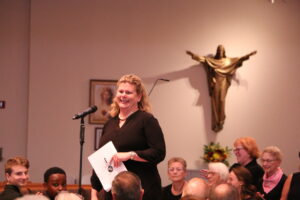
Dr. Christy Lee, director of music and liturgy at Our Lady of Fatima Parish in Alcoa, organized the performance.
The composition, written in 2011, is a setting of the Ordinary of the Mass for choir, vocal soloists, and bluegrass band.
The performance at OLOF had been in the works almost as soon as Dr. Christy Lee began working at the parish last summer as the director of music and liturgy.
“Tim Sharp has been a good colleague and friend of mine for about 20 years or so just in the music and choral world,” Dr. Lee explained.
Dr. Sharp is the former executive director of the American Choral Directors Association.
“We’ve stayed in touch and done different projects over the years in different academic and cultural settings,” Dr. Lee said. “So, when I first announced that I had gotten the job at Fatima last summer, a little over a year ago now, he reached out to me…and said, ‘I’m not sure if you’re aware of my ‘High Lonesome Mass,’ but since you’re going to be in East Tennessee, this might be something you would be interested in.’”
Dr. Lee was, in fact, familiar with his and Mr. Ramsay’s composition, and she was eager to connect with musicians and have it performed at OLOF.
The parish in Blount County sits at the foothills of the Great Smoky Mountains National Park, the heart of the southern Appalachians. For Dr. Lee and Dr. Sharp, it seemed like the perfect place for “A High Lonesome Mass,” composed of elements of the region’s musical and religious heritage.
“It seemed like a really beautiful fit, the way that [Sharp and Ramsay] combined the kind of more traditional and maybe somewhat Protestant Americana music superimposed with Latin text and with the Ordinary parts of the Mass,” Dr. Lee said.
Our Lady of Fatima Parish was able to host the performance with help from the diocesan Catholic Education Trust Fund. Dr. Sharp traveled from Nashville to conduct. Dr. Lee also arranged for the Knoxville Catholic High School choir, led by KCHS director of choral activities Phil Holloway, to perform two movements alongside the OLOF music ministry.
Father Peter Iorio, pastor of OLOF, opened the event with a welcome and prayer.
“I always think it’s a wonderful thing when we get to collaborate with our community,” he said. “One of the things that I reflected on is that we do live in a very special part of the world called Appalachia. It has a unique history and topography.”
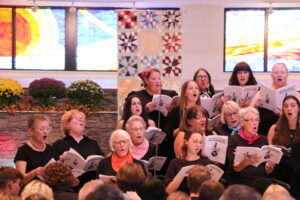
Our Lady of Fatima’s location near the mountains, along with folk art decorations like quilts, made the church a good setting for “A High Lonesome Mass.”
He then shared a passage from the 1995 pastoral letter from the Bishops of Appalachia, “At Home in the Web of Life”: “To live in these mountains and forests, and with their trees and plants and animals, is truly to dwell in Earth’s community of life, as one of God’s awesome cathedrals. In this magnificent work of God’s creation, misty mountain haze is holy incense, tall tree trunks are temple pillars, sun-splashed leaves are stained glass, and songbirds are angelic choirs. We humans, too, reveal the glory of God. Together with the mountains and forests, and with the plants and animals, we humans join creation’s praise of God in the choral song of the web of life.”
Before the performance began, Dr. Sharp led a short presentation on the blending of the ordinary Mass and bluegrass as well as an introduction to the backgrounds and components of bluegrass music.
“Characteristics unique to bluegrass include a combination of these mountain instruments [fiddle, bass, mandolin, banjo, guitar] that I talked about but also the shape-note voicing that included the high treble part above the melody, and that’s what we call the high, lonesome sound. If you read shape notes, there is a part in shape-note singing that is above the melody, and that is the high lonesome sound that I’m talking about.”
Shape notes, or sacred harp singing, is a musical notation style from the 19th century used for a capella, congregational singing where the notes have particular shapes to help the reader identify them on the scale. The hymns of this style were popular in many Protestant congregations in the American South and Appalachia.
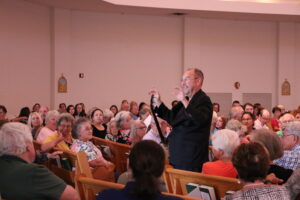
Dr. Sharp, banjo slung around his neck, leads the singers processing in during the first movement, “Introit—Come Away to the Skies.”
Appalachia also was the crucible for the birth of bluegrass music, forged in coal and lumber camps where immigrants came together with their different stringed instruments and musical styles.
“You will not hear too many bluegrass Masses in your life,” Dr. Sharp said. “One reason is that bluegrass music and choirs are not normally compatible. Bluegrass music, the mantra is play it faster, louder, hotter, better than the next guy to you, but the whole time, you have to do it humbly and with great humility to the person next to you. But still, hotter, faster, better. We inherited that from Bill Monroe.”
Dr. Sharp shared how his background of growing up in West Virginia, the son of a Baptist preacher, listening to bluegrass, and learning shape-note hymns from his grandmother contrasted to the classical music education he received in college. But ultimately, he found a way for them to work together.
“The work you’re going to hear, the High Lonesome Bluegrass Mass, is a mash-up of my classical choir chops and my bluegrass love put together in a choral work. Now, those of you who know the Mass will recognize the words very early on. The Kyrie is the Kyrie. The Sanctus, the Gloria, the Credo, the Agnus Dei, the Benedictus—these are our words as people of faith. And it’s not a caricature. This is absolutely a faith statement on my part. But it’s accompanied by bluegrass instruments. That’s where you’re going to get a little confused, because there are movements that have a really kind of Flatt and Scruggs kind of hot finger-picking kind of bluegrass. There are other movements that are more ballad style like Allison Krauss. There is one movement I write at the top, ‘Sing it like Ralph Stanley would have sung it.’”
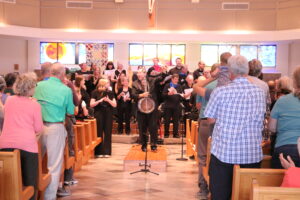
Knoxville Catholic High School choir members joined OLOF musicians in receiving a standing ovation for “A High Lonesome Mass.”
The performance presented traditional Mass parts incorporated into six movements: “Introit—Come Away to the Skies,” Kyrie Eleison—Do Lord Remember Me,” Gloria in Excelsis—Brethren We Have Met to Worship,” “High Lonesome Credo,” “Sanctus—Hail the Blessed Morn,” and “Agnus Dei—What Wondrous Love.”
The tunes transported the audience back to when plain wooden chapels dotted southern hills and the faithful within sang folk, shape-note hymns. Blended with the Church’s ancient use of Latin Gloria and Greek Kyrie, the music, so rooted by place, seemed to transcend time. It created a true gathering of Christian community, from across traditions and centuries.
Dr. Lee was grateful for all who helped make the event possible, from the OLOF staff to the musicians to Dr. Sharp.
“It’s been fun watching it all come together with all of the moving parts,” she said.
She also noted how special it was to host it at OLOF, in a church and with people who appreciated the spiritual depth of the music.
“It has been really wonderful for me to approach this work in a Catholic church as opposed to an academic setting or a different type of environment, because they relate to it in such a personal, spiritual way.
“A lot of us at Fatima or who are performing are natives of East Tennessee or natives of this region, so the fact that they can relate both to the Appalachian style and to the sacredness of the music is great to see.”

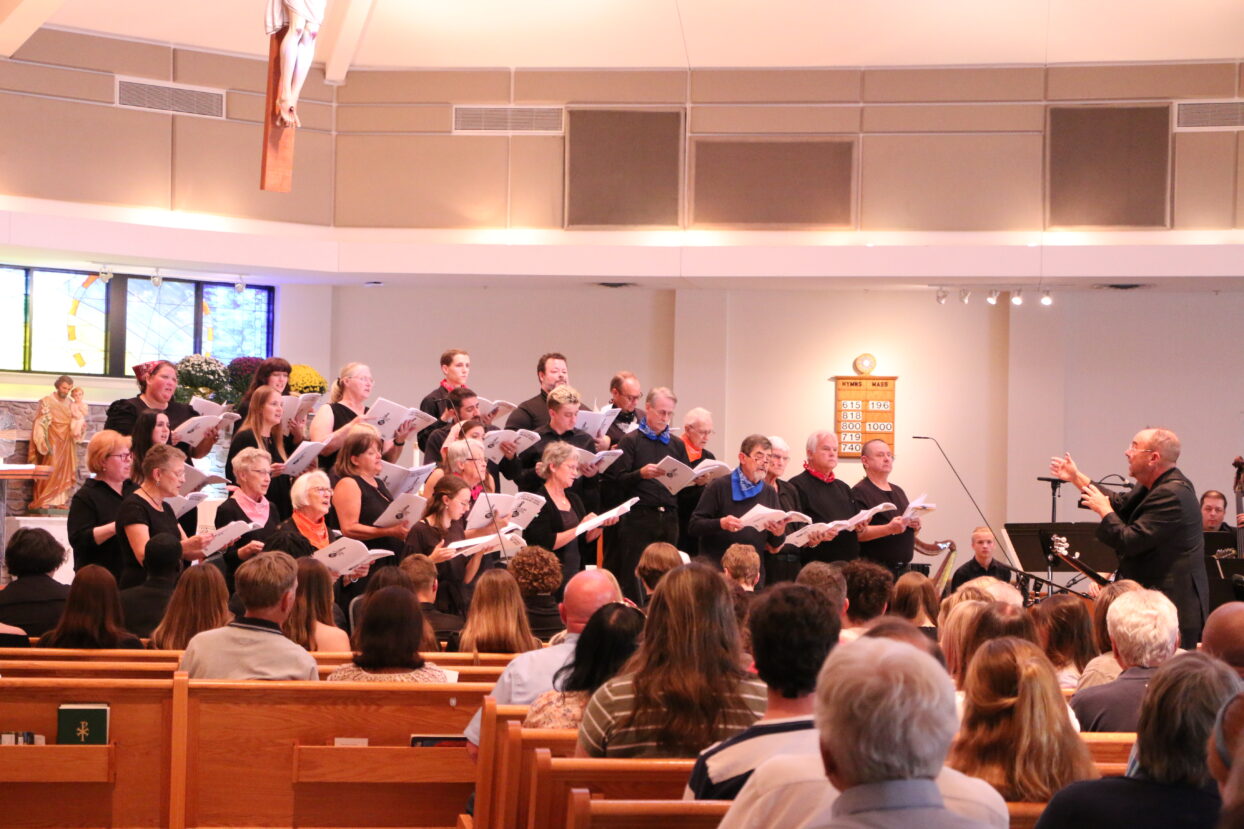
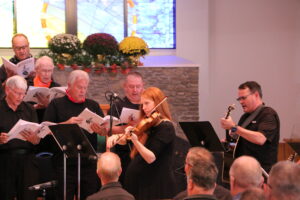
Comments 3
Sounds more like performance art than holy sacrifice of the Mass.
This is a performance piece. It would not be used to celebrate the Mass.
You are right. So are Mozart’s Requiem, Beethoven’s Misa Solemnis, and Bach’s Mass in B. All of these are choral works that beautifully present the text of the Mass, but are not intended to be used as the setting FOR a Mass. Had you attended this concert, you would have known that it was just that, a concert, respectfully and joyfully performed, with the blessed sacrament removed from the monstrance, as is proper. Concerts such as this have been performed in catholic churches for centuries.